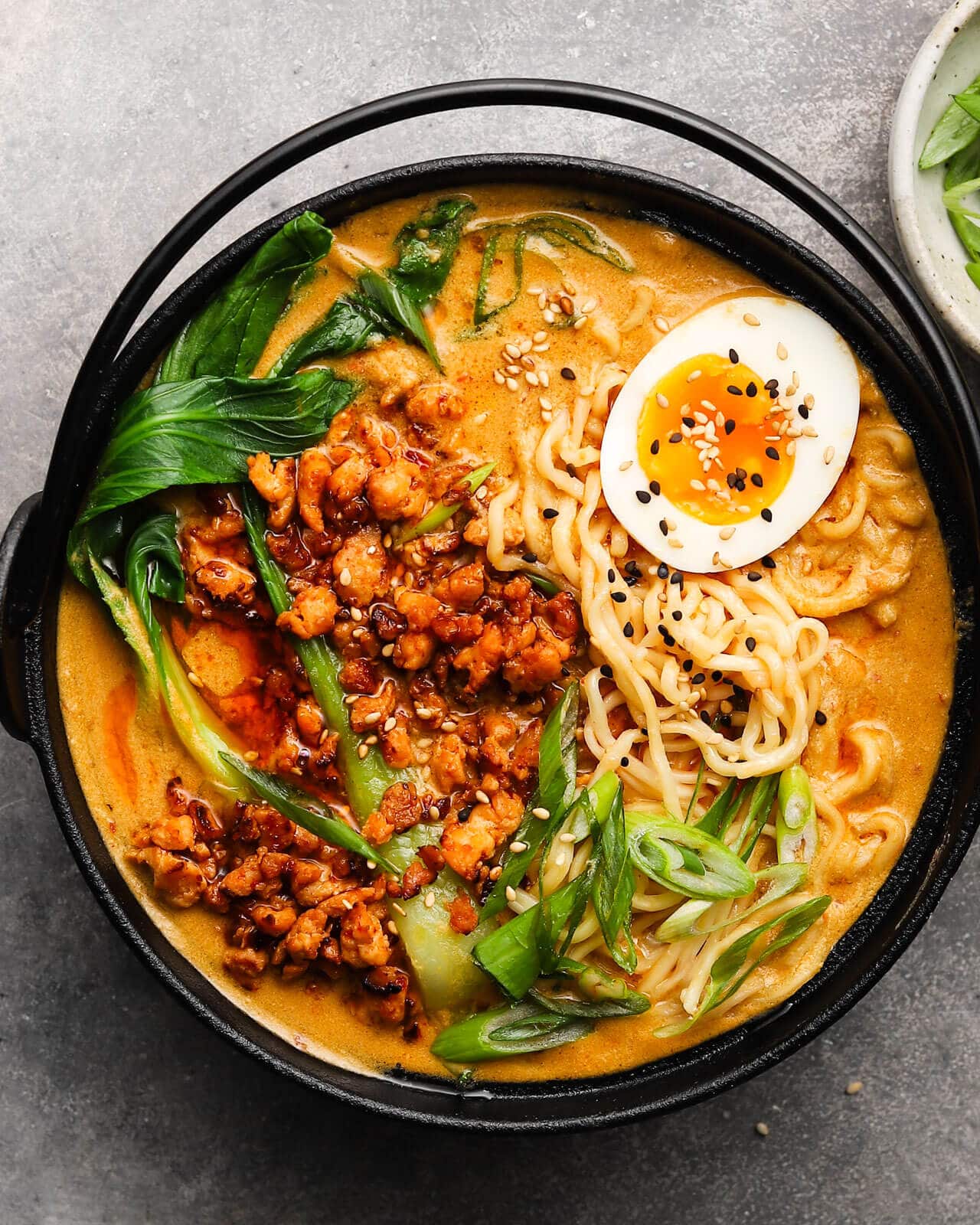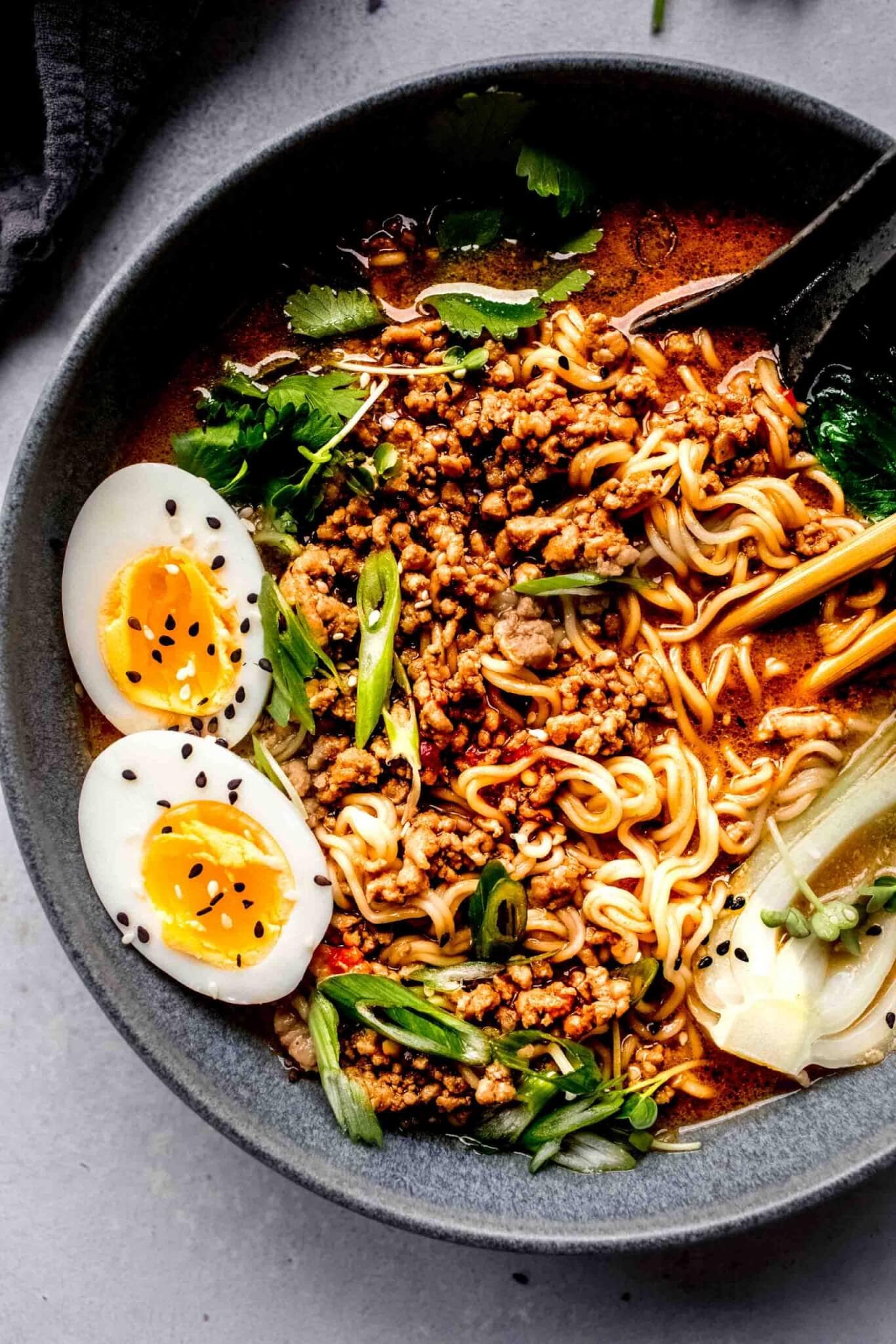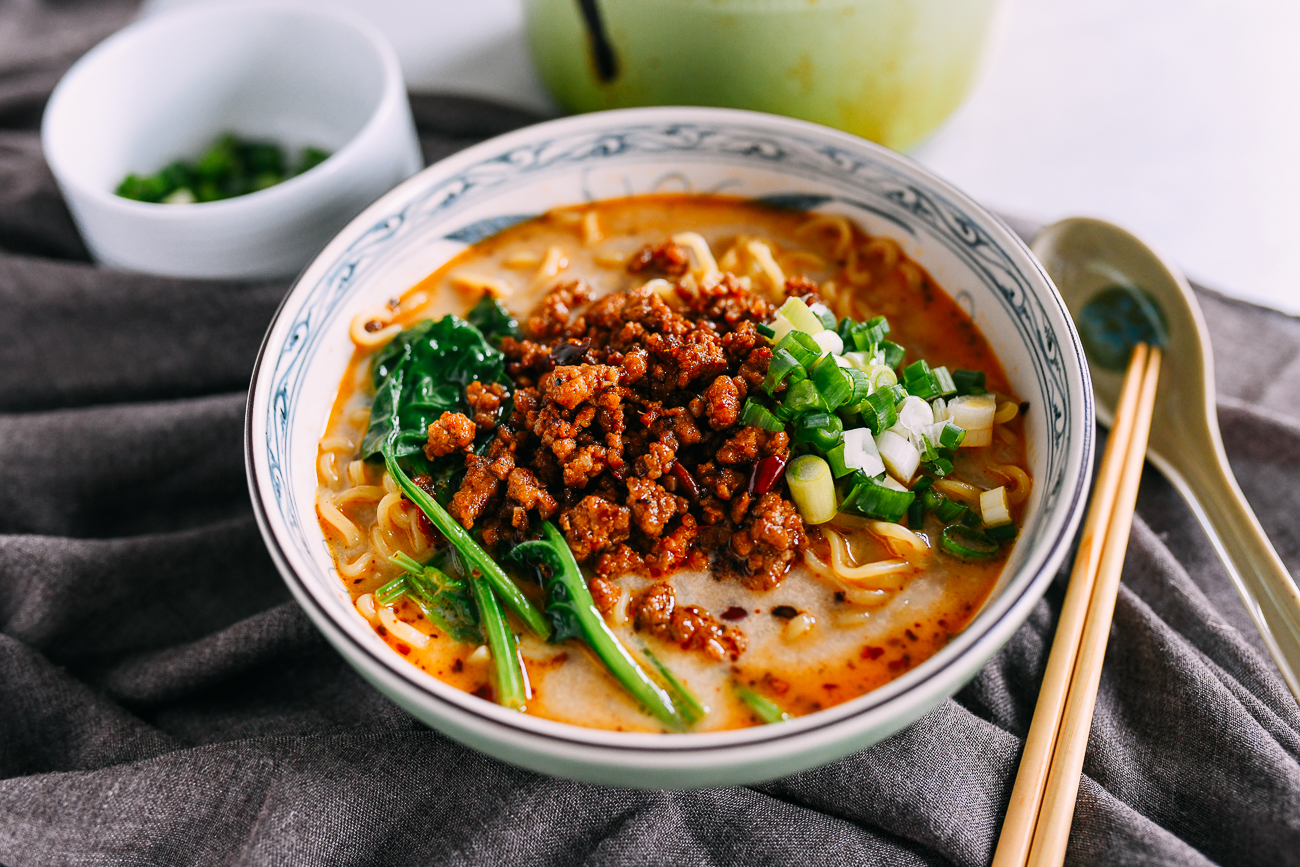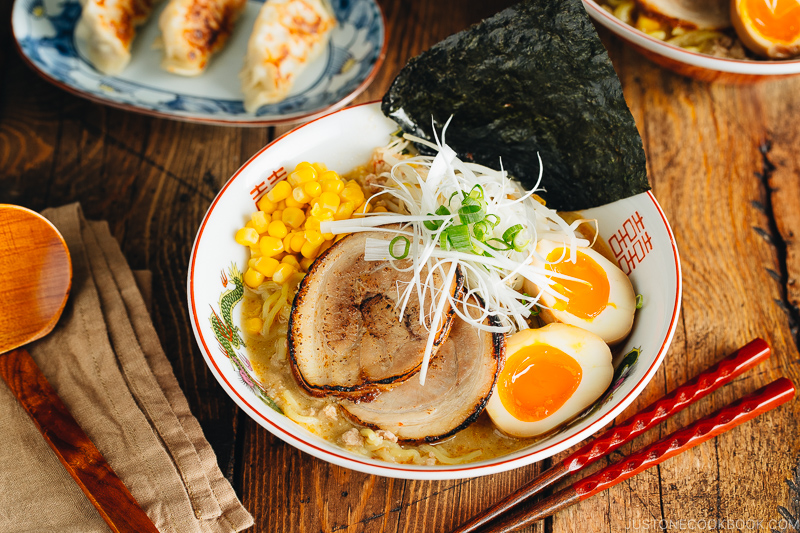Japanese Tantanmen Ramen is a mouthwatering and spicy dish that has gained popularity in Japan’s culinary scene. Inspired by traditional Sichuan cuisine, this unique ramen variation features a tantalizing combination of rich flavors and fiery spice. Tantanmen Ramen is beloved for its vibrant red broth, fragrant spices, and hearty toppings, making it a favorite among ramen enthusiasts.
The dish’s origins can be traced back to China, specifically the Sichuan province, where it was traditionally known as “Dan Dan Noodles.” Over time, Japanese chefs adapted the recipe, infusing it with their own culinary techniques and local ingredients to create the beloved Tantanmen Ramen we know today.

Japanese Tantanmen Ramen Recipe
Ingredients
Equipment
Method
- Add all the ingredients of the sauce i.e. oyster sauce, soy sauce, rice wine and Japanese fresh herbs into a large pan.
- Add the vegetables, minced pork, chopped tomatoes and the rest of the ingredients into the mixture.
- Cook the dish for ten minutes.
- Add the ramen into the mixture once the sauce is ready.
- Mix the ramen well.
- Cook the dish for five minutes.
- Add the cilantro and the green onions into the dish.
- Your dish is ready to be served.
Video
Notes
Some frequently asked questions (FAQs) about Japanese Tantanmen Ramen
1. What does “Tantanmen” mean?
“Tantanmen” is a Japanese term derived from the Chinese dish “Dan Dan Noodles.” It refers to a spicy ramen dish that typically features a rich and flavorful broth infused with chili oil and various spices.
2. How is Tantanmen different from other types of ramen?
Tantanmen stands out from other types of ramen due to its spicy and bold flavor profile. It incorporates a distinctive chili oil and spice blend, creating a fiery and aromatic broth. Additionally, Tantanmen often includes ground pork and a variety of vegetables as toppings, adding texture and depth to the dish.
3. Is Tantanmen Ramen very spicy?
The spiciness of Tantanmen Ramen can vary depending on personal preference and the specific recipe. Traditionally, it is known for its notable level of heat, thanks to the chili oil and spices used. However, the level of spiciness can be adjusted to suit individual tastes by controlling the amount of chili oil or adding milder ingredients.
4. What are the key ingredients in Tantanmen Ramen?
The key ingredients in Tantanmen Ramen include fresh ramen noodles, ground pork, vegetables (such as cabbage and bean sprouts), soy sauce, sesame paste, garlic, and a variety of spices and seasonings. Chili oil is a crucial component that adds the signature spiciness to the dish.
5. Can I make Tantanmen Ramen at home?
Absolutely! Tantanmen Ramen can be prepared at home with a bit of patience and the right ingredients. There are numerous recipes available online that provide step-by-step instructions for recreating this flavorful dish in your own kitchen. Experimenting with the level of spiciness and toppings allows you to customize the ramen to your liking.

6. Are there vegetarian or vegan versions of Tantanmen Ramen?
Yes, there are vegetarian and vegan adaptations of Tantanmen Ramen available. The ground pork can be substituted with plant-based alternatives like tofu or textured vegetable protein (TVP). Vegetable broth or mushroom-based broth can be used instead of meat-based broths, and the toppings can be adjusted to include vegetarian-friendly options such as mushrooms, tofu, or seitan.
7. Can I adjust the spiciness level of Tantanmen Ramen?
Yes, the spiciness level of Tantanmen Ramen can be adjusted to suit individual preferences. You can increase or decrease the amount of chili oil or chili flakes used in the recipe to control the heat. It’s always a good idea to start with a smaller amount and gradually add more until you achieve your desired level of spiciness.
8. What are some common garnishes for Tantanmen Ramen?
Common garnishes for Tantanmen Ramen include chopped spring onions, sesame seeds, shredded nori (seaweed), and a drizzle of chili oil. These toppings add additional flavor, texture, and visual appeal to the dish.
9. Can I find Tantanmen Ramen in Japanese restaurants outside of Japan?
Tantanmen Ramen has gained popularity worldwide, so it’s possible to find it in Japanese restaurants outside of Japan. However, availability may vary depending on the location and the specific restaurant. It’s always a good idea to check the menu or inquire with the restaurant beforehand if you’re specifically looking for Tantanmen Ramen.
10. Are there regional variations of Tantanmen Ramen in Japan?
Yes, there are regional variations of Tantanmen Ramen within Japan. Different regions may have their own unique twists on the dish, incorporating local ingredients or flavor profiles.
Cooking tips
Here are some cooking tips to help you make delicious Japanese Tantanmen Ramen at home:
1. Use fresh ingredients: Opt for fresh ramen noodles if possible, as they have a better texture and flavor compared to dried noodles. Fresh vegetables and high-quality ground pork will also enhance the overall taste of the dish.
2. Adjust spiciness to your preference: Tantanmen Ramen is known for its spiciness, but you can adjust the heat level to suit your taste. Start with a small amount of chili oil or chili flakes, then gradually increase the quantity until you achieve the desired level of spiciness.
3. Develop a flavorful broth: Take your time to simmer the broth to extract maximum flavor. Allow the broth ingredients to infuse together by simmering them for an extended period. This will result in a rich and well-rounded broth.
4. Toast the sesame seeds: Toasting sesame seeds before using them as a garnish adds a delightful nutty flavor to the dish. Heat a dry pan over medium heat, add the sesame seeds, and stir them until they turn golden brown.
5. Customize toppings: Feel free to experiment with toppings based on your preferences. While traditional toppings include sautéed ground pork, cabbage, and bean sprouts, you can add other ingredients such as sliced bamboo shoots, corn, or soft-boiled eggs.

6. Cook noodles properly: Follow the instructions on the package to cook the ramen noodles correctly. Overcooking can result in mushy noodles, while undercooking can leave them too firm. Cook them until they are al dente, firm but still tender.
7. Don’t forget the garnishes: Garnishes play a crucial role in enhancing the visual appeal and flavor of Tantanmen Ramen. Finely chopped spring onions, shredded nori (seaweed), and a drizzle of chili oil can elevate the overall presentation and taste of the dish.
8. Serve hot: Tantanmen Ramen is best enjoyed when served piping hot. Make sure to have your bowls ready, noodles cooked, broth heated, and toppings prepared before assembling and serving the ramen.
9. Adjust seasoning as needed: Taste the broth before serving and adjust the seasoning if necessary. Add more soy sauce, chili oil, or other seasonings to achieve the desired balance of flavors.
10. Enjoy the experience: Making Tantanmen Ramen is not just about the final dish; it’s also about the process. Enjoy the aromas, textures, and flavors that come together as you cook. Don’t be afraid to experiment and make the recipe your own.
With these tips in mind, you’ll be well on your way to creating a delicious and satisfying bowl of Japanese Tantanmen Ramen in your own kitchen. Happy cooking!
Serving Suggestions
Here’s a serving suggestion for Japanese Tantanmen Ramen:
1. Start by selecting your favorite ramen bowls. Preheat them by filling them with hot water while you prepare the ramen.
2. Once the ramen noodles are cooked and strained, divide them evenly among the preheated bowls.
3. Ladle the hot and flavorful Tantanmen broth over the noodles, ensuring each bowl receives a generous amount of broth.
4. Arrange the toppings on top of the noodles and broth. Common toppings include sautéed ground pork, sliced cabbage, bean sprouts, and chopped spring onions. You can also add other toppings such as soft-boiled eggs, sliced bamboo shoots, or corn for extra flavor and texture.
5. Drizzle some chili oil over the toppings if desired, for an added kick of spiciness.

6. Sprinkle toasted sesame seeds and shredded nori (seaweed) over the bowl for additional flavor and visual appeal.
7. Serve the Tantanmen Ramen immediately while it’s hot. Accompany it with a pair of chopsticks and a spoon for enjoying the noodles and savoring the rich broth.
8. Optional condiments and seasonings can be served on the side, such as soy sauce, extra chili oil, or chili flakes, allowing each person to adjust the flavors according to their preference.
9. Consider serving the ramen with a side of pickled vegetables, such as Japanese-style pickled cucumbers or kimchi, to add a refreshing and tangy element to the meal.
10. Enjoy the Tantanmen Ramen while it’s still steaming hot. Slurp the noodles, savor the rich broth, and relish the combination of flavors and textures in each bite.
Remember, presentation is key, so take your time to arrange the toppings and garnishes in an appealing manner. Enjoy the delicious and spicy Japanese Tantanmen Ramen with your family or friends for a satisfying and memorable dining experience!








